Fear is a normal part of life. In fact, it’s necessary for our survival as a species. However, fear also has an insidious way of preventing us from taking actions necessary for growth—for achieving greater physical, emotional, and financial wellbeing. Succumbing to fear can ultimately leave us steeped in regret and falling dramatically short of fulfilling our human potential. And no one wants that!
The irony? Most of our biggest, deepest fears never even happen!
When we stop trying to avoid fear and instead expose and examine it in the cold light of day, its grip on us softens. We realize that we have more control over our circumstances than we initially thought and we become empowered to take actions that we previously thought were too difficult or even outright impossible.
Learning how to uncover our fears, examine them, and then take action in spite of them IS the one true path to success in any area of our lives. One technique I recently learned, called fear-setting, can help you do just that.
Check out this video to watch me guide you through the fear-setting technique, or read on for the main points.
(This post contains affiliate links, which means—at zero cost to you—I will earn a small commission if you click through and make a purchase. Thank you for your support!)
What is Fear-Setting?
What we fear doing most is usually what we most need to do. —Tim Ferriss
Fear-setting is a powerful technique that can help you expose, examine, and largely eliminate the fears that have been holding you back. I learned this technique largely from The 4-Hour Work Week author Tim Ferriss, who adapted the technique from Stoic principles.
In sum, the technique asks you to think of the worst-case scenarios with respect to a particular decision or action you’re about to take and then closely examine the potential negative and positive outcomes of making the decision or taking the action.
Whether it’s a tough conversation you’ve been putting off, a big decision you’ve been mulling over, or a major opportunity you’re considering in your business or personal life, this powerful exercise can help. Let’s walk through the steps in more detail.
The Fear-Setting Exercise
First, grab a piece of paper and a pen. Write the decision you need to make or the situation you’ve been avoiding at the top of the page, then draw two vertical lines down the page to create three columns.
Once you’ve got your columns, write the word Define at the top of one of them, Prevent at the top of the next one, and Repair above the third one. For my example, I’ll use quitting a job to go full-time with your own business.
Negative Outcomes
In the first column, define the absolute worst-case scenario. What are your worst fears with respect to taking action in this situation? Would you die? Would there even be any permanent impacts?
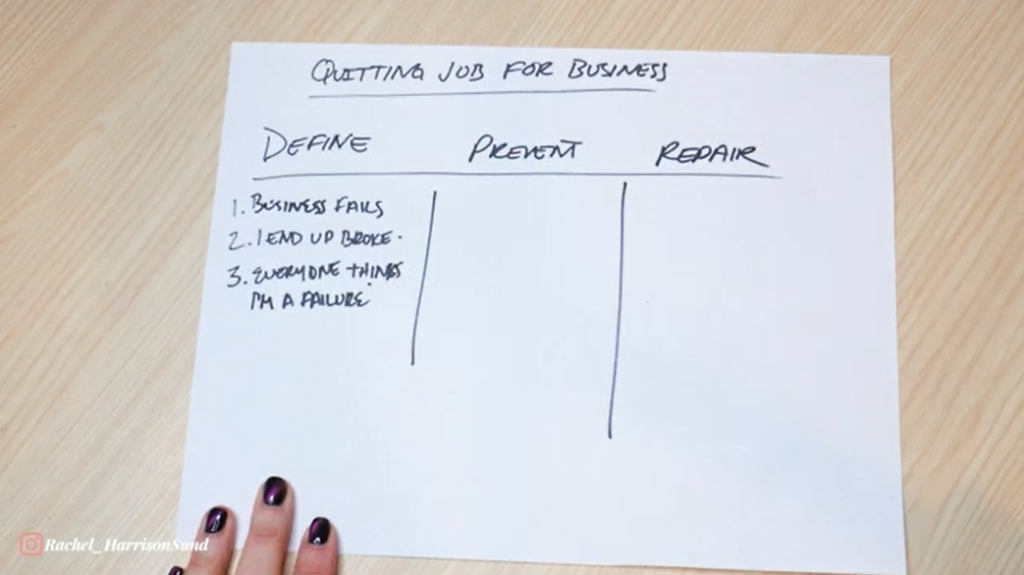
Give each scenario a score between 1 and 10 in terms of the ultimate setback you’d actually experience, with 1 being minimal impact and 10 being permanently life-changing negative consequences.
Next, in column two, list all the ways you could reduce or prevent the likelihood of your worst-case scenario from actually happening.
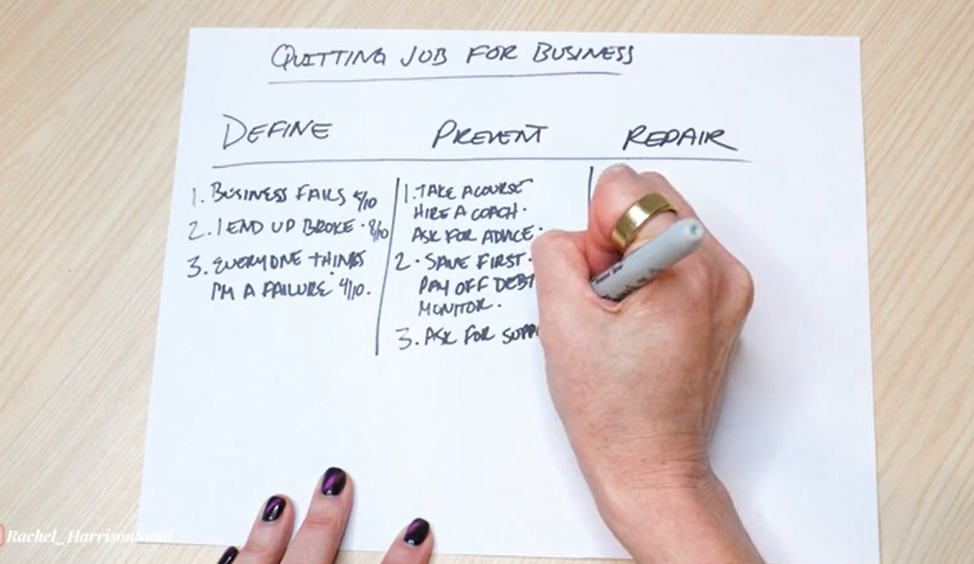
Finally, in column three, write down all the steps you could take to repair the damage and get things back on track and under control if your worst-case scenario actually came true.
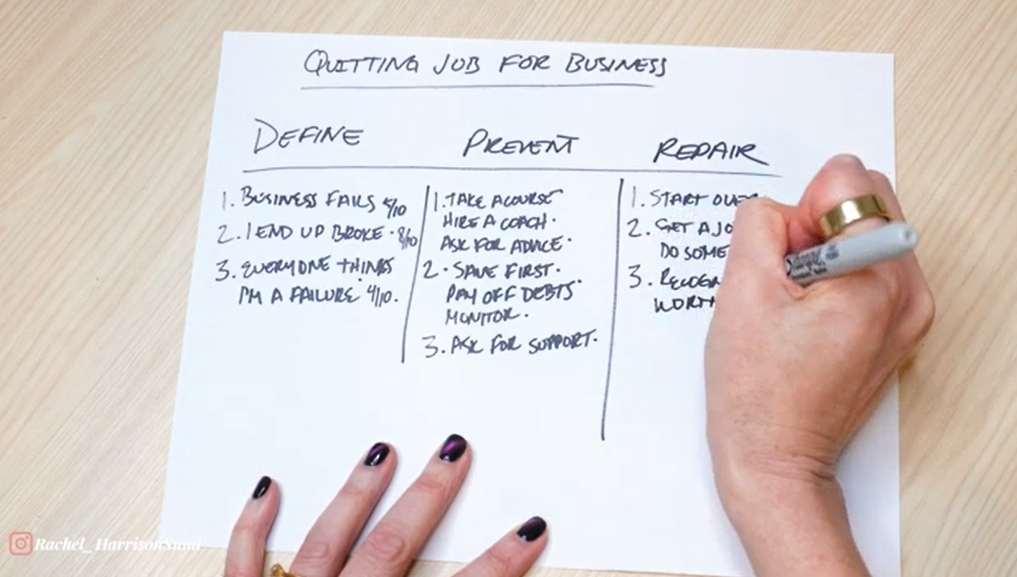
After this first part of the exercise is done you should already start to realize that even if things went sideways and your absolute worst-case scenario did come to pass, you would ultimately be okay and life would go on!
Positive Outcomes
The second part of the fear-setting exercise deals with positive outcomes. Flip your paper over and list all of the potential benefits of making this decision or taking this action and achieving full or partial success.
Give each benefit a score between 1 and 10 in terms of the ultimate benefit you’d receive, with 1 being little to no benefit and 10 being the most benefit possible. These benefits could be external—more money, time, or freedom—but they could also be internal, like experiencing more joy, happiness, or confidence.
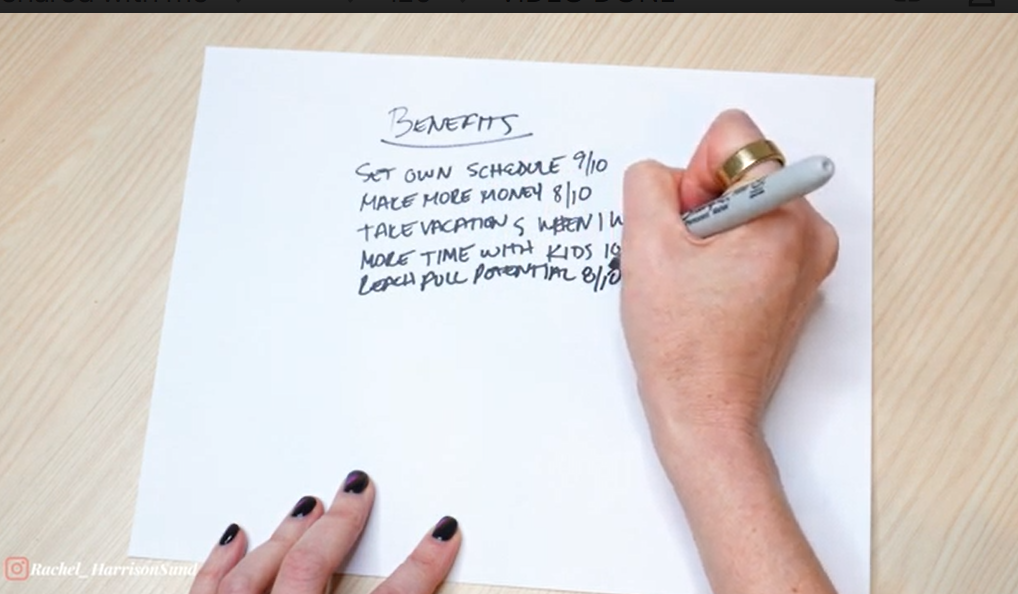
The Cost of Inaction
Finally, you’re going to assess the consequences of inaction. What will it cost you—financially, emotionally, or physically—to kick this can down the road or not take action at all? Where will you be in six months, a year, and five years if you remain stuck in the status quo.
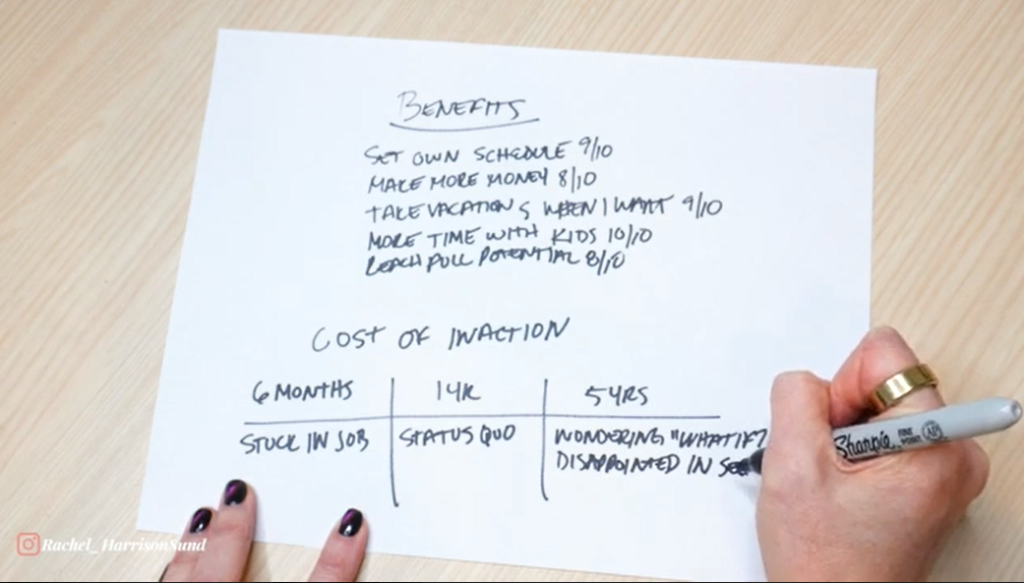
What You Can Learn From Fear-Setting
After you’re done the full exercise you’ll almost certainly realize these four things:
- The likelihood of the worst-case scenario happening in real life is much less than you thought.
- There are concrete actions you can take to prevent the worst outcomes from ever happening in the first place.
- Even if your worst-case scenario nightmare comes true, you already know how to regain control of the situation and get yourself back on track.
- The benefits of taking action—even if you fail and even if your nightmare worst-case scenario actually comes true—almost always outweigh the costs of inaction.
These realizations will drain the power from your fears. Although the fear may not completely be eliminated, taking action will suddenly become a lot easier.
I didn’t realize it at the time, but I’ve been doing a mental version of this exercise for a while. This technique has really helped me in times when I know I’ve needed to do something but I’m feeling shit-scared.
When I was about to launch my course, Low-Content Profits Academy, for the first time, I was absolutely petrified of delivering a live webinar. I sometimes experience social anxiety in high-stress environments and I had about 400 attendees registered for my very first webinar. I was completely terrified that I might have a panic attack during the live event. I was actually laying in bed sobbing a couple days beforehand!
I was finally able to calm myself down by asking, “What’s the worst thing that could happen if I did have a panic attack? Would I die? Would I pass out? Would I suddenly lose my ability to speak and go completely blank? Would I just simply stumble over a few words? And how likely was it really that any of that would actually happen?”
Obviously I wasn’t going to die, and it was pretty unlikely that I would pass out. I was well-prepared with lots of notes, so if I did go blank I could literally just read my notes. I also reminded myself that most people would be understanding if I did come across as nervous. If I stumbled over my words (which I did) I could just laugh it off and move on. In the end I realized that I could recover quickly if anything did go wrong.
Then I asked myself, “What is the cost of NOT doing the live webinar?”
First, I’d be completely disappointed in myself for letting fear drive my decision. I also knew I’d be leaving a lot of money on the table.
In the end, I knew the pain of letting my fear win and not doing the webinars would be much worse than the pain of any of my fears actually happening.
So…I did the damn webinar! This did NOT remove my discomfort, but it gave me the strength to feel the fear and do it anyway, which is a necessary skill if you want to accomplish anything amazing in your life.
I felt a lot more confident in myself after doing those webinars, AND I also made over $60k on that first launch, so it was definitely worth it.
You can use this fear-setting exercise anytime you’re wrestling with, avoiding, or putting off a vital decision, whether it’s:
- asking for a raise
- having a difficult conversation
- taking a year-long sabbatical
- traveling the world
- or any other decision!
Whatever the scenario is, try this exercise and then sit back and watch the amazing life that you actively create for yourself unfold.
If you’re an aspiring online entrepreneur and you feel like you could use a little help mapping out your first steps and setting a clear path forward, download my free guide, “The 4-Step ‘No Time to Waste’ Online Business Start Up Blueprint.” You’re also invited to join my free Facebook group, Rachel’s Sandbox.
